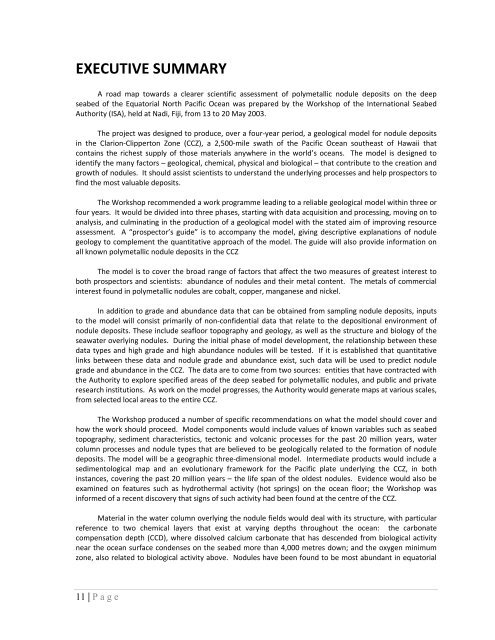Workshop on the Establishment of a Geological Model of ...
Workshop on the Establishment of a Geological Model of ...
Workshop on the Establishment of a Geological Model of ...
You also want an ePaper? Increase the reach of your titles
YUMPU automatically turns print PDFs into web optimized ePapers that Google loves.
EXECUTIVE SUMMARY<br />
A road map towards a clearer scientific assessment <strong>of</strong> polymetallic nodule deposits <strong>on</strong> <strong>the</strong> deep<br />
seabed <strong>of</strong> <strong>the</strong> Equatorial North Pacific Ocean was prepared by <strong>the</strong> <str<strong>on</strong>g>Workshop</str<strong>on</strong>g> <strong>of</strong> <strong>the</strong> Internati<strong>on</strong>al Seabed<br />
Authority (ISA), held at Nadi, Fiji, from 13 to 20 May 2003.<br />
The project was designed to produce, over a four‐year period, a geological model for nodule deposits<br />
in <strong>the</strong> Clari<strong>on</strong>‐Clippert<strong>on</strong> Z<strong>on</strong>e (CCZ), a 2,500‐mile swath <strong>of</strong> <strong>the</strong> Pacific Ocean sou<strong>the</strong>ast <strong>of</strong> Hawaii that<br />
c<strong>on</strong>tains <strong>the</strong> richest supply <strong>of</strong> those materials anywhere in <strong>the</strong> world’s oceans. The model is designed to<br />
identify <strong>the</strong> many factors – geological, chemical, physical and biological – that c<strong>on</strong>tribute to <strong>the</strong> creati<strong>on</strong> and<br />
growth <strong>of</strong> nodules. It should assist scientists to understand <strong>the</strong> underlying processes and help prospectors to<br />
find <strong>the</strong> most valuable deposits.<br />
The <str<strong>on</strong>g>Workshop</str<strong>on</strong>g> recommended a work programme leading to a reliable geological model within three or<br />
four years. It would be divided into three phases, starting with data acquisiti<strong>on</strong> and processing, moving <strong>on</strong> to<br />
analysis, and culminating in <strong>the</strong> producti<strong>on</strong> <strong>of</strong> a geological model with <strong>the</strong> stated aim <strong>of</strong> improving resource<br />
assessment. A “prospector’s guide” is to accompany <strong>the</strong> model, giving descriptive explanati<strong>on</strong>s <strong>of</strong> nodule<br />
geology to complement <strong>the</strong> quantitative approach <strong>of</strong> <strong>the</strong> model. The guide will also provide informati<strong>on</strong> <strong>on</strong><br />
all known polymetallic nodule deposits in <strong>the</strong> CCZ<br />
The model is to cover <strong>the</strong> broad range <strong>of</strong> factors that affect <strong>the</strong> two measures <strong>of</strong> greatest interest to<br />
both prospectors and scientists: abundance <strong>of</strong> nodules and <strong>the</strong>ir metal c<strong>on</strong>tent. The metals <strong>of</strong> commercial<br />
interest found in polymetallic nodules are cobalt, copper, manganese and nickel.<br />
In additi<strong>on</strong> to grade and abundance data that can be obtained from sampling nodule deposits, inputs<br />
to <strong>the</strong> model will c<strong>on</strong>sist primarily <strong>of</strong> n<strong>on</strong>‐c<strong>on</strong>fidential data that relate to <strong>the</strong> depositi<strong>on</strong>al envir<strong>on</strong>ment <strong>of</strong><br />
nodule deposits. These include seafloor topography and geology, as well as <strong>the</strong> structure and biology <strong>of</strong> <strong>the</strong><br />
seawater overlying nodules. During <strong>the</strong> initial phase <strong>of</strong> model development, <strong>the</strong> relati<strong>on</strong>ship between <strong>the</strong>se<br />
data types and high grade and high abundance nodules will be tested. If it is established that quantitative<br />
links between <strong>the</strong>se data and nodule grade and abundance exist, such data will be used to predict nodule<br />
grade and abundance in <strong>the</strong> CCZ. The data are to come from two sources: entities that have c<strong>on</strong>tracted with<br />
<strong>the</strong> Authority to explore specified areas <strong>of</strong> <strong>the</strong> deep seabed for polymetallic nodules, and public and private<br />
research instituti<strong>on</strong>s. As work <strong>on</strong> <strong>the</strong> model progresses, <strong>the</strong> Authority would generate maps at various scales,<br />
from selected local areas to <strong>the</strong> entire CCZ.<br />
The <str<strong>on</strong>g>Workshop</str<strong>on</strong>g> produced a number <strong>of</strong> specific recommendati<strong>on</strong>s <strong>on</strong> what <strong>the</strong> model should cover and<br />
how <strong>the</strong> work should proceed. <strong>Model</strong> comp<strong>on</strong>ents would include values <strong>of</strong> known variables such as seabed<br />
topography, sediment characteristics, tect<strong>on</strong>ic and volcanic processes for <strong>the</strong> past 20 milli<strong>on</strong> years, water<br />
column processes and nodule types that are believed to be geologically related to <strong>the</strong> formati<strong>on</strong> <strong>of</strong> nodule<br />
deposits. The model will be a geographic three‐dimensi<strong>on</strong>al model. Intermediate products would include a<br />
sedimentological map and an evoluti<strong>on</strong>ary framework for <strong>the</strong> Pacific plate underlying <strong>the</strong> CCZ, in both<br />
instances, covering <strong>the</strong> past 20 milli<strong>on</strong> years – <strong>the</strong> life span <strong>of</strong> <strong>the</strong> oldest nodules. Evidence would also be<br />
examined <strong>on</strong> features such as hydro<strong>the</strong>rmal activity (hot springs) <strong>on</strong> <strong>the</strong> ocean floor; <strong>the</strong> <str<strong>on</strong>g>Workshop</str<strong>on</strong>g> was<br />
informed <strong>of</strong> a recent discovery that signs <strong>of</strong> such activity had been found at <strong>the</strong> centre <strong>of</strong> <strong>the</strong> CCZ.<br />
Material in <strong>the</strong> water column overlying <strong>the</strong> nodule fields would deal with its structure, with particular<br />
reference to two chemical layers that exist at varying depths throughout <strong>the</strong> ocean: <strong>the</strong> carb<strong>on</strong>ate<br />
compensati<strong>on</strong> depth (CCD), where dissolved calcium carb<strong>on</strong>ate that has descended from biological activity<br />
near <strong>the</strong> ocean surface c<strong>on</strong>denses <strong>on</strong> <strong>the</strong> seabed more than 4,000 metres down; and <strong>the</strong> oxygen minimum<br />
z<strong>on</strong>e, also related to biological activity above. Nodules have been found to be most abundant in equatorial<br />
11 | P age
















